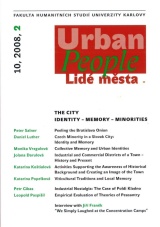Introduction to the Thematic Issue The City – Identity – Memory – Minorities
DOI:
https://doi.org/10.14712/12128112.3705Abstrakt
Every city derives its character from its own history. This history finds its roots in the layout of the city, its monuments and memorials, its symbols, but also in the structured memory of its inhabitants. Some places in a city absorb several temporal layers of memory and the oldest can, with time, slip away in temporary or permanent forgetting. It is not always a question of natural processes; memory can be replaced in a violent or controlled manner: urban renewals, forced expulsion of a population, etc. However, a city also has the ability to flash back to its past: a walk through historic streets and quiet corners can bring back to the receptive walker what that space was like in the past. Often connected to the invocation of memories is nostalgia: valid and invalid phenomena. The preservation of a significant point on the timeline of a city requires a combination of the past with the present and the future: history loses its importance if it cannot be used for updating. People search in a city’s history so that, with its support, they can master the present or, more precisely, project their interests into the past. That is, each of us has only those eyes granted to him by his time. In a city there are, to be sure, areas filled with meaning and also areas that, at least for the moment, are meaningless. However, one cannot exclude the idea that even, for example, uniform hypermarket chains, sweeping away differences among European cities that are historically founded or constructing their identity on history, are still waiting for their history.
Stahování
Publikováno
Jak citovat
Číslo
Sekce
Licence

Tato práce je licencována pod Mezinárodní licencí Creative Commons Attribution-NonCommercial-NoDerivatives 4.0.


